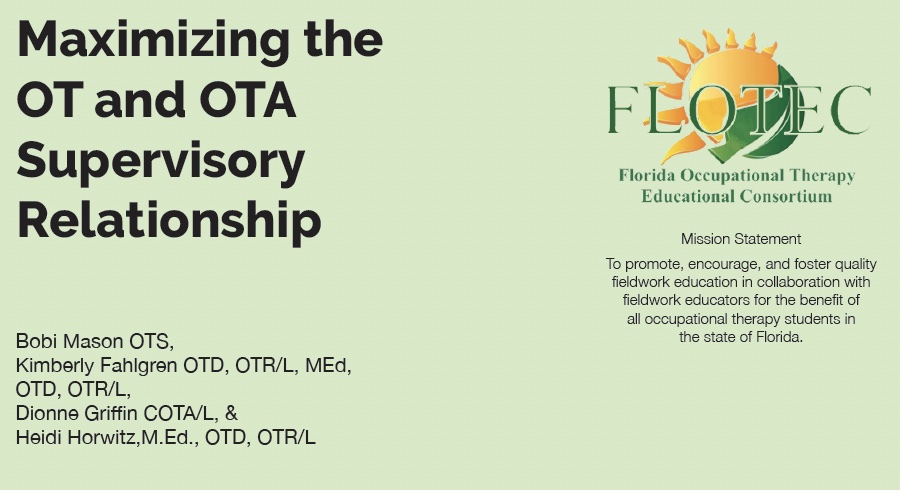
The Accreditation Council for Occupational Therapy Education (ACOTE®) standards and the Standards of Practice for Occupational Therapy identify the collaborative roles of OT/ OTA intraprofessional responsibilities (Accreditation Council for Occupational Therapy Education [ACOTE], 2018; American Occupational Therapy Association [AOTA], 2020, 2015). According to the American Occupational Therapy Association (AOTA, 2022), there are 16 occupational therapy and 20 occupational therapy assistant programs in Florida. The 2022 U.S. Bureau of Labor and Statistics Occupational Outlook Handbook reports 6,770 occupational therapists and 2,550 occupational therapy assistants licensed in Florida (U.S. Bureau of Labor Statistics, 2022). The employment rates for occupational therapy practitioners are growing exponentially, with an expected increase of 24% for OTAs and OT aides and 14% for OTs by 2031 (U.S. Bureau of Labor Statistics, 2022). With the growing demand for occupational therapy practitioners, the profession must ensure that OT and OTA students and practitioners have the knowledge and skills to promote quality supervisory and collaborative relationships to ensure best practices for our clients. This process should start in the educational environment.
A literature review found research on collaborative learning models to implement supervision strategies and encourage intraprofessional OT/OTA supervision. Halle et al. (2019) reported that students with direct faculty onsite supervision demonstrated improved proficiency in working on interprofessional teams. Carson et al. (2018) researched intraprofessional educational didactic experience between OT and OTA students by examining socialization, role delineation, case studies, and planned group intervention. The study demonstrated OT and OTA effectiveness in promoting the application of learned skills/ information (Carson et al., 2018); However, in a different study “no outcomes measured actual performance that demonstrated mastery of collaborative intraprofessional practice” (Pitonyak et al., 2020, p. 4). Approaches to enhance competencies of practice through didactic curriculum and fieldwork experiences are necessary; however, rarely is this discussed in the literature. A study on OT/OTA competency (Pitonyak et al., 2020) reported that the majority of participants selected work experience as the primary method contributing to service competency in intraprofessional collaboration. How can we ensure best practices for our clients when OTs and OTAs are learning competency on the job?
“There is scant literature examining intraprofessional collaboration, in general, and within the profession of occupational therapy” (Pitonyak et al., 2020, p. 2). In contrast, we can find research on effective, evidence based solutions for interprofessional teamwork. Effective interprofessional strategies can be easily transferable for use to improve supervision, collaboration, and service competency in OT/OTA intra-professional relationships:
- Healthcare education programs create and implement participation in interprofessional education (IPE) activities early in their program [can] improve the student’s knowledge of the roles of other [OT] practitioners, effective communication, collaboration, patient safety, and enhance leadership skills (Diggele et al., 2020).
- Simulated activities allow students to rehearse roles and improve collaboration skills with other [OT] practitioners in a healthcare setting (Washington et al., 2021)
- Meaningful and effective socialization opportunities to gain knowledge of [OT] practitioners’ roles aid in collaborative efforts to improve patient outcomes (Washington et al., 2021).
Suggestions for intra-professional education on OT and OTA relationships that can improve supervisory skills and career readiness:
Increase collaboration between OTs and OTAs during the educational experience through in person activities if the proximity of programs allows.
- Increase collaboration between OTs and OTAs during the educational experience through virtual learning experiences using video conferencing technologies. • Provide role-playing activities to OT students explicitly about the supervisory OT/ OTA relationship during the content on leadership and management within the didactic aspect of the program.
- Increase collaboration between OT and OTA programs during the placement of students in fieldwork by placing an OT and an OTA at the same site, thereby increasing interaction and learning opportunities.
- Require OT/OTA supervision with direct supervision from a site mentor during fieldwork experiences and incorporating OT/OTA didactic coursework during the leadership and professionalism courses.
Additional attention and research are needed on the OT and OTA supervisory relationship to improve career- preparedness, self-efficacy, and service competency. “ACOTE does not provide details needed to design educational programming in professional, fieldwork, or academic settings in order own curricula” (Pitonyak et al., 2020, p. 3). Adapting new verbiage to the ACOTE® Standards of Practice to include a requirement for face- to-face or virtual OT and OTA supervisory experiences during didactic education and fieldwork can promote and encourage intra-professional learning within educational programs. The field of occupational therapy can demonstrate professional leadership as a model for other professions on how to work intra-professionally with excellence.
References
Accreditation Council for Occupational Therapy Education [ACOTE]. (2018). Accreditation Council for Occupational Therapy Education (ACOTE®) Standards and Interpretive Guide. https://acoteonline. org/wp-content/uploads/2020/10/2018ACOTE-Standards.pdf
American Occupational Therapy Association [AOTA]. (2015). Standards of practice for occupational therapy. American Journal of Occupational Therapy, 69(Suppl. 3), 1-6. https://doi.org/10.5014/ ajot.2015.696S06
American Occupational Therapy Association. (2020). Guidelines for supervision, roles, and responsibilities during the delivery of occupational therapy services. American Occupational Therapy Association, 74(Supplement 3), 7413410020p1–7413410020p6. https://doi.org/10.5014/ajot.2020.74S3004
American Occupational Therapy Association. (2022). Find an OT or OTA school. https://www.aota.org/education/finda-school
Carson, N. E., Crawford, J., & Hanner, N. (2018). Creating opportunities for OT-OTA student learning through community collaborations. Service Journal of Occupational Therapy Education, 2(2), 1-16. https://doi.org/10.26681/jote.2018.020208
Diggele, C.V., Roberts, C., Burgess, A., & Mellis C. (2020). Interprofessional education: tips for design and implementation. BMC Medical Education, 20(2), 455. https://doi.org/10.1186/ s12909-020-02286-z
Halle, A. D., Kaloostian, C., & Stevens, G. D. (2019). Occupational therapy student learning on interprofessional teams in geriatric primary care. The American Journal of Occupational Therapy, 73(5), 7305185050p1-7305185050p10. https://doi.org/10.5014/ ajot.2019.037143
Pitonyak, J. S., Corsilles-Sy, C., Diamant, R. B., & James, A.B. (2020). Examining the educational and professional learning contexts where occupational therapy practitioners gained competencies for intraprofessional collaboration. Journal of Occupational Therapy Education, 4(4), 1-21. https://doi. org/10.26681/jote.2020.040413
U.S. Bureau of Labor Statistics. (2022). Occupational Outlook Handbook. https://www.bls.gov/ooh/home.htm
Washington, V. L., Zakrajsek, A., Myler, L., Seurynck, K., Holt, S., & Scazzero, J. (2021). Blending interprofessional education and simulation learning: A mixed-methods study of an interprofessional learning experience with nursing and occupational therapy students. Journal of Interprofessional Care, 1–6.
